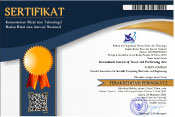*corresponding author
AbstractMelody is the soul of Indian classical music. A musician presents different captivating melodic motions of a certain set of notes, showing their diverse permutations and combinations as well as their hidden beauty. This melodic exposition decorates the mind with several melodic expressions and embellishments and is hence referred to as RÄg – which brings aesthetic pleasure. The main objective of this research is the presentation and style of certain rags, as well as the improvisation of the melodic structure. The data obtained by recording the song's melody audio technique and watching the concert live and all of them will be used to analyze and check the composition of the song. The musical analysis is carried out with respect to RÄg. This is because a composition like a mirror reflects a complete picture of an RÄg. It reveals and also retains its characteristics, such as its ascending and descending notes, its dominating notes, other sub-dominant notes, its intricacies, and its special combination of notes, i.e., svara-sañgati. The different BandÄ«Å›-s in an RÄg highlight the different aspects and shades in which it can be rendered. The results of this study indicate that compositions in Indian music are a combination of traits that includes the aspects of the musical structure, vocal style and techniques, instrumentation, rhythmic style, and poetry. BandÄ«Å› in KhyÄl of Hindustani music refers to the text of the composition. The text is marked by the elegant use of words. The musical structure of BandÄ«Å›-s is comprised of certain essential laya (Tempo), tÄl (beat), RÄg (melody), and dhÄtu-s (the melodic component)
KeywordsKhyÄl; SadÄraṇga; Hindustani music; BandiÅ› alÄp; RÄg
|
DOIhttps://doi.org/10.31763/viperarts.v4i1.633 |
Article metrics10.31763/viperarts.v4i1.633 Abstract views : 1561 | PDF views : 385 |
Cite |
Full Text Download Download
|
References
[1] S. Sen, “The Melody of Universalism: Political Thought in Rabindra Sangeet,†Soc. Cult. South Asia, vol. 9, no. 1, pp. 104–127, Jan. 2023, doi: 10.1177/23938617221080439.
[2] M. Rahaim, “Gesture and melody in Indian vocal music,†Gesture, vol. 8, no. 3, pp. 325–347, Dec. 2008, doi: 10.1075/gest.8.3.04rah.
[3] E. O. Henry, “The Rationalization of Intensity in Indian Music,†Ethnomusicology, vol. 46, no. 1, pp. 33–55, Jan. 2002, doi: 10.2307/852807.
[4] M. Velankar, A. Deshpande, and P. Kulkarni, “Melodic pattern recognition in Indian classical music for raga identification,†Int. J. Inf. Technol., vol. 13, no. 1, pp. 251–258, Feb. 2021, doi: 10.1007/s41870-018-0245-6.
[5] S. K. Pudaruth, “A Reflection on the Aesthetics of Indian Music, With Special Reference to Hindustani Raga-Sangita,†SAGE Open, vol. 6, no. 4, p. 215824401667451, Oct. 2016, doi: 10.1177/2158244016674512.
[6] G. Zavracky, “Beyond the Spirituals: Harry T. Burleigh’s Five Songs of Laurence Hope,†J. Sing., vol. 78, no. 5, pp. 559–568, Apr. 2022, doi: 10.53830/NHHB5331.
[7] M. A. Castellano, J. J. Bharucha, and C. L. Krumhansl, “Tonal hierarchies in the music of North India,†J. Exp. Psychol. Gen., vol. 113, no. 3, pp. 394–412, 1984, doi: 10.1037/0096-3445.113.3.394.
[8] N. Moran, “Music, bodies and relationships: An ethnographic contribution to embodied cognition studies,†Psychol. Music, vol. 41, no. 1, pp. 5–17, Jan. 2013, doi: 10.1177/0305735611400174.
[9] R. Bansal and K. P. Karanth, “Molecular phylogeny of Hemidactylus geckos (Squamata: Gekkonidae) of the Indian subcontinent reveals a unique Indian radiation and an Indian origin of Asian house geckos,†Mol. Phylogenet. Evol., vol. 57, no. 1, pp. 459–465, Oct. 2010, doi: 10.1016/j.ympev.2010.06.008.
[10] R. Widdess, “The oral in writing: early Indian musical notations,†Early Music, vol. 24, no. 3, pp. 391–406, Aug. 1996, doi: 10.1093/em/24.3.391.
[11] G. Farrell, “The early days of the gramophone industry in India: Historical, social and musical perspectives,†Br. J. Ethnomusicol., vol. 2, no. 1, pp. 31–53, Jan. 1993, doi: 10.1080/09681229308567211.
[12] D. Clarke, “North Indian Classical Music and Lerdahl and Jackendoff’s Generative Theory – a Mutual Regard,†Music Theory Online, vol. 23, no. 3, pp. 1–30, Sep. 2017, doi: 10.30535/mto.23.3.3.
[13] C. Alaghband-Zadeh, “Listening to North Indian Classical Music: How Embodied Ways of Listening Perform Imagined Histories and Social Class,†Ethnomusicology, vol. 61, no. 2, pp. 207–233, Jul. 2017, doi: 10.5406/ethnomusicology.61.2.0207.
[14] J. M. Valla, J. A. Alappatt, A. Mathur, and N. C. Singh, “Music and Emotion—A Case for North Indian Classical Music,†Frontiers in Psychology, vol. 8. 19-Dec-2017, doi: 10.3389/fpsyg.2017.02115.
[15] R. Widdess, “Aspects of form in North Indian ÄlÄp and dhrupad,†in Music and tradition: essays on Asian and other musics presented to Laurence Picken, 1981, pp. 143–182. Available at: Google Scholar.
[16] D. A. Jasen and T. J. Tichenor, Rags and ragtime: A musical history. Courier Corporation, 2013. Available at: Google Scholar.
[17] P. Loui, D. L. Wessel, and C. L. H. Kam, “Humans Rapidly Learn Grammatical Structure in a New Musical Scale,†Music Percept., vol. 27, no. 5, pp. 377–388, Jun. 2010, doi: 10.1525/mp.2010.27.5.377.
[18] F. Delvoye, “Music patronage in the Sultanate of Gujarat: a survey of sources,†in New Developments in Asian Studies, Routledge, 2013, pp. 342–360. doi: 10.4324/9780203039199-17
[19] F. Orsini, “How to do multilingual literary history? Lessons from fifteenth- and sixteenth-century north India,†Indian Econ. Soc. Hist. Rev., vol. 49, no. 2, pp. 225–246, Jun. 2012, doi: 10.1177/001946461204900203.
[20] K. Butler Schofield, “Learning to Taste the Emotions: The Mughal Rasika,†in Tellings and Texts: Music, Literature and Performance in North India, Open Book Publishers, 2015, pp. 407–422. doi: 10.11647/OBP.0062.15
[21] M. Clayton, “Time, Gesture and Attention in a KhyÄl Performance,†Asian Music, vol. 38, no. 2, pp. 71–96, 2007, doi: 10.1353/amu.2007.0032.
[22] B. Wade, “Chiz in Khyal: The Traditional Composition in the Improvised Performance,†Ethnomusicology, vol. 17, no. 3, pp. 443–459, Sep. 1973, doi: 10.2307/849960.
[23] S. Kugle, “The Spirituality of Qawwali,†in The Wiley Blackwell Companion to Islamic Spirituality, Wiley, 2022, pp. 454–475. doi: 10.1002/9781118533789.ch24
Refbacks
- There are currently no refbacks.
Copyright (c) 2022 Bilambita Banisudha

This work is licensed under a Creative Commons Attribution-ShareAlike 4.0 International License.
___________________________________________________________
International Journal of Visual and Performing Arts
ISSN 2684-9259
Published by Association for Scientific Computing Electronics and Engineering (ASCEE)
W: http://pubs2.ascee.org/index.php/viperarts
E: sularso@ascee.org
Organized by:
 This work is licensed under a Creative Commons Attribution-ShareAlike 4.0
This work is licensed under a Creative Commons Attribution-ShareAlike 4.0
























